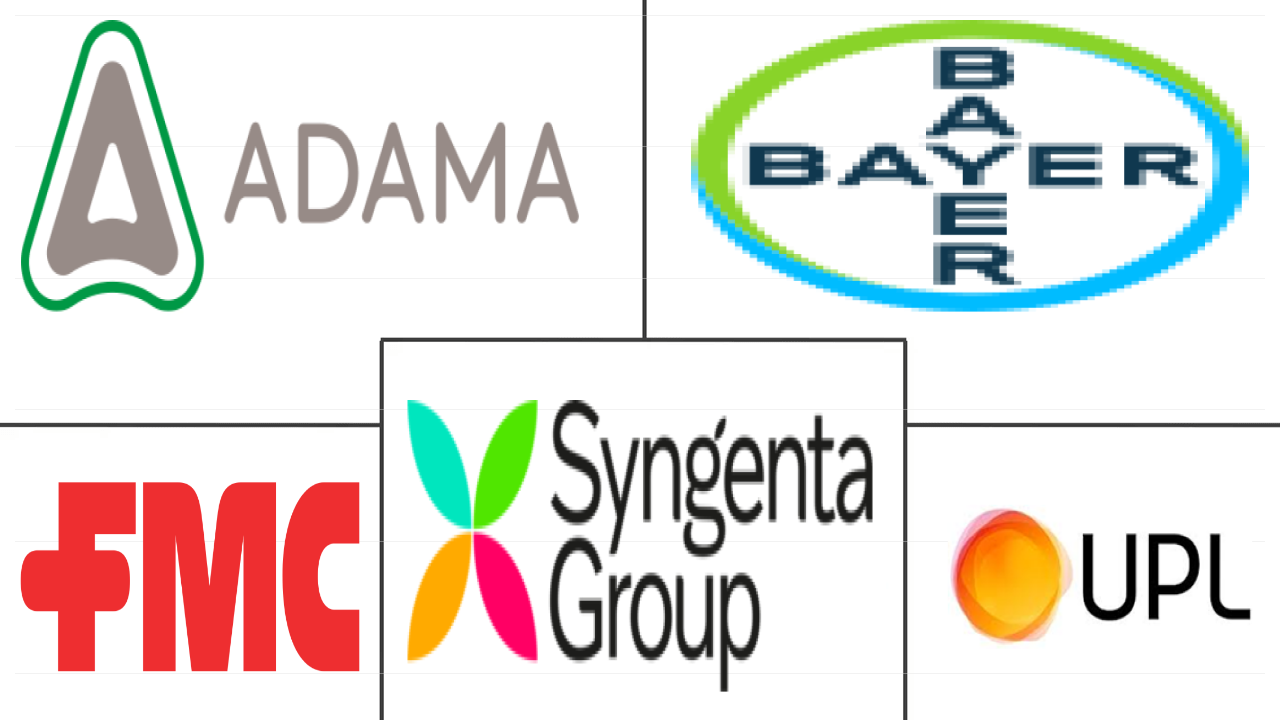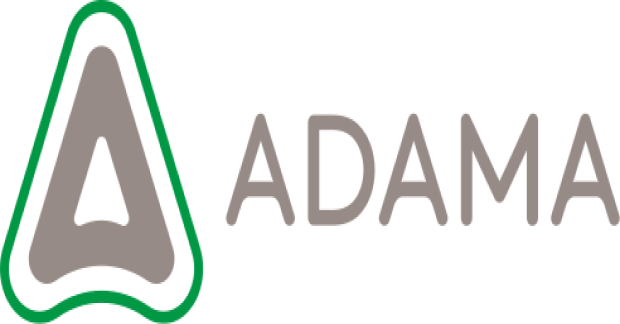Market Size of africa nematicide Industry
| Icons | Lable | Value |
|---|---|---|
|
|
Study Period | 2017 - 2029 |
|
|
Market Size (2024) | USD 4.88 Million |
|
|
Market Size (2029) | USD 5.62 Million |
|
|
Largest Share by Application Mode | Soil Treatment |
|
|
CAGR (2024 - 2029) | 2.85 % |
|
|
Largest Share by Country | South Africa |
|
|
Market Concentration | High |
Major Players |
||

|
||
|
*Disclaimer: Major Players sorted in no particular order |
Africa Nematicide Market Analysis
The Africa Nematicide Market size is estimated at 4.88 million USD in 2024, and is expected to reach 5.62 million USD by 2029, growing at a CAGR of 2.85% during the forecast period (2024-2029).
4.88 Million
Market Size in 2024 (USD)
5.62 Million
Market Size in 2029 (USD)
1.59 %
CAGR (2017-2023)
2.85 %
CAGR (2024-2029)
Largest Segment by Application Mode
68.21 %
value share, Soil Treatment, 2023
Soil treatment method encompasses techniques like surface application and subsurface application, which have proven to be highly economical in numerous cases of nematodes.
Largest Segment by Crop Type
46.15 %
value share, Grains & Cereals, 2023
Grain and cereal crops are susceptible to various nematode species, such as root-knot nematodes and cyst nematodes, which can decrease yields by hindering their growth.
Largest Segment By Country
29.90 %
value share, South Africa, 2023
South Africa has a market-oriented agricultural economy that is highly diverse and includes major grains, oilseeds, deciduous and subtropical fruits, and vegetables.
Leading Market Player 1
22.44 %
market share, ADAMA Agricultural Solutions Ltd, 2022

The company has a portfolio of over 270 active ingredients and 22 production sites that are responsible for the manufacturing and supply of products worldwide, including Africa.
Leading Market Player 2
20.04 %
market share, Syngenta Group, 2022

The company invests more than USD 1.3 billion per year globally in R&D to develop advanced, innovative technologies and agrochemical products to address farmers’ challenges.
Soil application of nematicides dominated the market owing to fewer risks of exposing non-target organisms
- In Africa, nematodes in agriculture are effectively controlled through the use of various modes of applying nematicides. By selecting the appropriate application method, farmers can save costs, as they can efficiently apply the nematicides, cover specific areas, and reduce wastage. This improved efficiency leads to optimal usage and lowers input costs for farmers.
- Other application methods, such as soil application and foliar application of nematodes, generally pose fewer risks of exposing non-target organisms. The dominant mode of nematicide application in agricultural practices is soil application, accounting for 68.2% of the overall application segment in 2022. Grains and cereals hold the largest market share at 46.0%. This is because the nematicide remains primarily in the soil where the target nematodes reside and their effectiveness in protecting the quality of grains and cereals by preventing or reducing nematodes.
- In 2022, foliar applications accounted for 14.2% of the African nematicide market. Its primary purpose is to manage nematode infestations in inflorescences and leaves. Chrysanthemum nematodes, a type of foliar nematode, are typically found in buds and leaves but may also be present in soil. These nematodes can also harm ornamental plants and crops like roses and tomatoes, causing stunted growth, wilting, and reduced yields.
- In Africa, there is a growing concern among farmers due to the rising crop losses caused by nematode infestations each year. The use of nematicides is increasing to enhance crop productivity and profitability. The mode of nematicide application is expected to witness significant growth, with a projected CAGR of 2.8% during the forecast period.
The focus of African farmers on nematode management to achieve optimal crop health and maximize yield is expected to drive the market
- Africa has a diverse agricultural sector. Nematodes can have a significant impact on various crops, including grains, fruits, vegetables, and others, leading to crop losses. As a result, there is a growing need for nematicides to control nematode populations and reduce crop damage. As of 2022, the region accounted for a value of USD 4.6 million in the overall global nematicide market.
- In 2022, the Rest of Africa was the main purchaser of nematicide products. The Rest of Africa accounted for 70.3% of the total nematicide market's value in Africa. As farmers in the region implement more efficient nematode control methods, the demand for nematicides is expected to increase, leading to an increase in the market share of the Rest of Africa. It is expected to record a CAGR of 2.4% from 2023 to 2029.
- During the forecast period (2023-2029), the nematicide market in South Africa is projected to have the highest growth rate compared to other countries, with a CAGR of 3.7%. In South Africa, plant nematodes cause an estimated annual yield loss of approximately 14% in cereal, vegetable, and fruit crops. Due to this, there is an increased demand for nematicides to effectively control nematodes, leading to the expected rapid expansion of the market.
- With the expansion of crop cultivation, increased awareness of nematode-related crop damage, and the growing focus on advanced agriculture practices, the demand for nematicides as an effective solution for nematode control is expected to rise. Therefore, the African nematicide market is expected to record a CAGR of 2.8% during the forecast period (2023-2029).
Africa Nematicide Industry Segmentation
Chemigation, Foliar, Fumigation, Seed Treatment, Soil Treatment are covered as segments by Application Mode. Commercial Crops, Fruits & Vegetables, Grains & Cereals, Pulses & Oilseeds, Turf & Ornamental are covered as segments by Crop Type. South Africa are covered as segments by Country.
- In Africa, nematodes in agriculture are effectively controlled through the use of various modes of applying nematicides. By selecting the appropriate application method, farmers can save costs, as they can efficiently apply the nematicides, cover specific areas, and reduce wastage. This improved efficiency leads to optimal usage and lowers input costs for farmers.
- Other application methods, such as soil application and foliar application of nematodes, generally pose fewer risks of exposing non-target organisms. The dominant mode of nematicide application in agricultural practices is soil application, accounting for 68.2% of the overall application segment in 2022. Grains and cereals hold the largest market share at 46.0%. This is because the nematicide remains primarily in the soil where the target nematodes reside and their effectiveness in protecting the quality of grains and cereals by preventing or reducing nematodes.
- In 2022, foliar applications accounted for 14.2% of the African nematicide market. Its primary purpose is to manage nematode infestations in inflorescences and leaves. Chrysanthemum nematodes, a type of foliar nematode, are typically found in buds and leaves but may also be present in soil. These nematodes can also harm ornamental plants and crops like roses and tomatoes, causing stunted growth, wilting, and reduced yields.
- In Africa, there is a growing concern among farmers due to the rising crop losses caused by nematode infestations each year. The use of nematicides is increasing to enhance crop productivity and profitability. The mode of nematicide application is expected to witness significant growth, with a projected CAGR of 2.8% during the forecast period.
| Application Mode | |
| Chemigation | |
| Foliar | |
| Fumigation | |
| Seed Treatment | |
| Soil Treatment |
| Crop Type | |
| Commercial Crops | |
| Fruits & Vegetables | |
| Grains & Cereals | |
| Pulses & Oilseeds | |
| Turf & Ornamental |
| Country | |
| South Africa | |
| Rest of Africa |
Africa Nematicide Market Size Summary
The Africa nematicide market is experiencing a steady growth trajectory, driven by the increasing need to combat nematode infestations that significantly impact agricultural productivity. Farmers in the region are adopting various application methods, with soil application being the most prevalent due to its efficiency and cost-effectiveness. The market is characterized by a diverse agricultural landscape, where nematodes pose a threat to a wide range of crops, including grains, fruits, and vegetables. This has led to a rising demand for nematicides as a crucial tool for enhancing crop yields and ensuring food security. The market is expected to expand further as awareness of nematode-related crop damage grows and advanced agricultural practices are implemented.
South Africa is anticipated to lead the market growth within the region, driven by the substantial yield losses caused by plant parasitic nematodes in key crops. The market is fairly consolidated, with major players like ADAMA Agricultural Solutions Ltd, Bayer AG, FMC Corporation, Syngenta Group, and UPL Limited dominating the landscape. These companies are actively investing in research and development to enhance their product offerings and address the challenges posed by nematodes. The increasing prices of active ingredients such as Fluensulfone and Abamectin reflect the growing demand and limited availability, further influencing market dynamics. As farmers continue to seek effective solutions to mitigate nematode damage, the market for nematicides in Africa is poised for continued growth.
Africa Nematicide Market Size - Table of Contents
-
1. MARKET SEGMENTATION (includes market size in Value in USD and Volume, Forecasts up to 2029 and analysis of growth prospects)
-
1.1 Application Mode
-
1.1.1 Chemigation
-
1.1.2 Foliar
-
1.1.3 Fumigation
-
1.1.4 Seed Treatment
-
1.1.5 Soil Treatment
-
-
1.2 Crop Type
-
1.2.1 Commercial Crops
-
1.2.2 Fruits & Vegetables
-
1.2.3 Grains & Cereals
-
1.2.4 Pulses & Oilseeds
-
1.2.5 Turf & Ornamental
-
-
1.3 Country
-
1.3.1 South Africa
-
1.3.2 Rest of Africa
-
-
Africa Nematicide Market Size FAQs
How big is the Africa Nematicide Market?
The Africa Nematicide Market size is expected to reach USD 4.88 million in 2024 and grow at a CAGR of 2.85% to reach USD 5.62 million by 2029.
What is the current Africa Nematicide Market size?
In 2024, the Africa Nematicide Market size is expected to reach USD 4.88 million.

